#deep sea arthropods
Photo


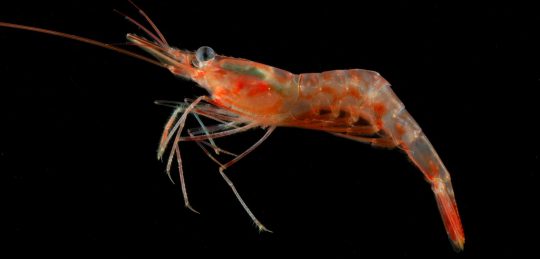
The Shrimp-ly Wonderful Northern Shrimp
A common sight in grocery stores worldwide, Pandalus borealis is known by many names, including the northern shrimp, the pink shrimp, the deep-sea prawn, and the coldwater prawn. In fact, the species is not a prawn but a shrimp; the difference is that shrimp have one pair of legs ending in claws while prawns have three pairs. P. borealis can be found along muddy ocean floors throughout the northern Atlantic and Pacific-- though some regard the two populations as being separate species. Within this range, they typically inhabit cold waters, from -1 °C to 6 °C (30 °F to 43 °F).
As the name implies, pink shrimp are bright pink or red in color, though parts of their bodies are somewhat translucent. Males are smaller than females, at only 12 cm (4.7 in) to their 16 cm (6 in) in length. As a decapod, they have ten legs; the first three pairs, called the maxillipeds are used as mouth parts, while the rest are adapted for swimming. The abdomen is divided into six segments, while the head and the thorax are fused together and protected by a thick shell known as the carapace. P. borealis’ eyes are compound eyes, like those of an insect, and are excellent at detecting movement in the dim light of the deep ocean. Additionally, their long antennae allow it to smell and taste chemicals in the water, assessing the location and suitability of prey.
The coldwater prawn lives in large schools of up to several hundred, though they have no set social structure and do not defend territories. They spend most of their time on the ocean floor, feeding on plankton and carrion. In the coldest parts of the Arctic, this makes them important members of the food web as they can recycle nutrients back into the system. In addition to widespread human predation, a number of octopi, seals, and fish are known to feed on the pink shrimp where available.
P. borealis breeds once a year, from July to September. Males release pheromones as they approach females to signal they are ready to breed, and afterwards the female will carry the stored sperm for up to eight months before fertilizing her eggs. In spring, while the water is still cold, egg-carrying females will migrate close to shore and lay their eggs-- up to 5,000 in a single clutch. The hatched larvae are all male, though they will go through six molts over the course of a year before migrating back to deeper waters and becoming sexually active. They will remain reproductive males for only about a year before molting again and transitioning to female; this is a type of hermaphroditism known as protandry. Individuals will spend the rest of their lives-- typically about eight years-- as a female.
Conservation status: Though they have not been evaluated by the IUCN, the pink shrimp is considered severely overfished in many parts of its native range. Trawling in particular poses a serious threat, as parts of a school not caught will still become stressed and die before reaching maturity. Ocean warming has also damaged populations, since this species thrives only in cold water.
If you like what I do, consider leaving a tip or buying me a ko-fi!
Photos
David Shale
Greenland Institute of Natural Resources
Erling Svenson
#northern shrimp#pink shrimp#Decapoda#Pandalidae#pandalid shrimp#true shrimp#shrimp#decapods#crustaceans#Arthropods#marine fauna#marine arthropods#benthic fauna#benthic arthropods#deep sea#deep sea arthropods#atlantic ocean#Pacific Ocean#animal facts#biology#zoology#queer animals#queer fauna
133 notes
·
View notes
Text

#shitpost#random#idk lol#lol#funny#humor#funny memes#meme#inspiration#isopods#isoposting#marine biology#marine life#deep sea#sea floor#arthropods#giant isopod
66 notes
·
View notes
Text

Copepod
“Lernaeolophus sultanus (Copepoda, Pennellidae), a parasite of the deep-sea fish Pristipomoides filamentosus (Lutjanidae), off New Caledonia. Scale, each scale division – 1 mm.” - via Wikimedia Commons
#poll for formatting preference is above ⬆️#wikipedia#wikipedia pictures#nature#animals#parasite#parasites#parasitology#marine biology#Pristipomoides filamentosus#Lernaeolophus sultanus#marine life#marine animals#sea life#sea animals#fish#icthyology#oceancore#deep sea#lutjanidae#copepoda#arthropoda#crustacean#arthropod
37 notes
·
View notes
Text
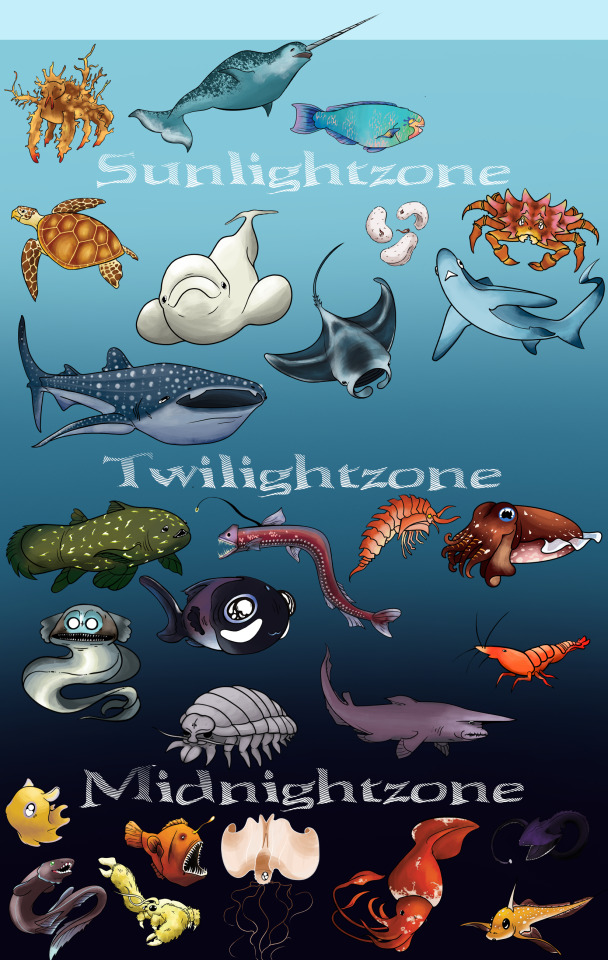
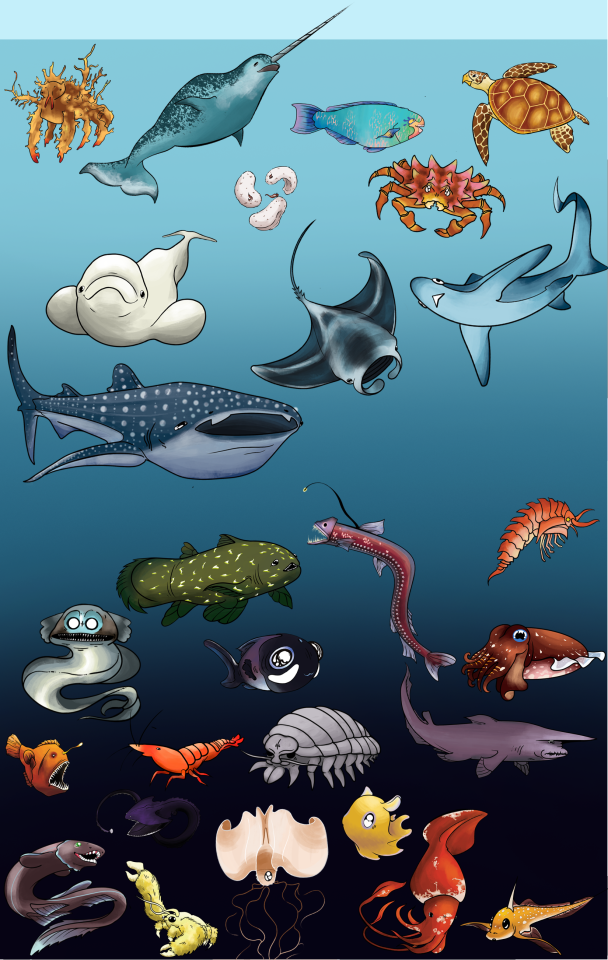

Ocean zones and their respective inhabitants.
Want posters of these? Check our shop!
#art#sea creatures#deep sea#sea art#artists on tumblr#fish#midnight zone#ocean art#shark art#crabs#yeti crabs#chimera#telescope fish#thresher shark#viper fish#cuttlefish#cephalopod#arthropod#crustacean#angler fish#gulper eel#eel#whale shark#shrimp#octopus#squid#whale#beluga#ray#sting ray
77 notes
·
View notes
Text
Had a sudden moment of CLARITY and anyway Russian Buggy
Buggy who's multilingual and whose cultural development is EXPANSIVE but who also clings to his roots a bit.
Buggy who, upon losing EVERYTHING after Roger's execution, drifted for a while, and then decided to return to his homeland - to know where he came from, to find where he will go.
He finds home and community and he learns. He learns so much and his access to the language comes as easily as breathing to him - something both surprising and not, given his proclivities with learning. He takes to it like a fish to water, and he carries that home, that place, that history, on with him even still to this day.
Just. Idk, I feel like his voice and cadence would sound LOVELY in Russian and I feel like he'd actually THRIVE with that and yes I was watching a Chernobyl documentary but LEAVE ME ALOJE LET ME COOK-
#buggy the clown#headcanons#sleepy thoughts#plz god i am so tired#why yes i do work two jobs and also dabble in silly goosery#i am a busy bee#and a sleepy bee#i love bees#and insects in general love me some arthropods too#hah imagine a deep sea one piece au#oh no-
7 notes
·
View notes
Text
INVERTEBRATE TOURNAMENT:
Sea Invertebrates CHAMPIONSHIP
It’s been a long road, but finally we can make a choice about which sea invertebrate is best. Our two candidates are both formidable— the Octopus, eight-limbed mollusk and cephalopod, renowned for its intelligence and ability to squeeze through tight spaces, and the Deep Sea Isopod, giant underwater cousin to our land invertebrate champion, the pillbug. Will the octopus’s impressive intellect help it win a victory against this deep sea scavenger? Only one way to find out, so without further ado, let’s get this poll started—
Wait. Hold on, we’re getting reports of a new challenger arriving at the stadium. But that can’t be! This is the championship! What invertebrate would have the audacity to enter the tournament this far in, to challenge the two that beat all the others? And where is this new challenger, anyways? I can’t quite see where they—
NO, No, wait just a moment! The new challenger approaches! A tiny little eight-legged beast known as the Water Bear and Moss Piglet but related to neither, it took a while for this sturdy “slow stepper” to get here but he’s right in time! Everyone meet THE TARDIGRADE!!!!!!!!! What do you think, folks?




#polls#tumblr polls#poll#tumblr poll#invertebrates#nature#nature polls#animals#giant isopod#isopod#deep sea#isopods#arthropods#cephalopod#mollusk#octopus#tardigrade#water bear#moss piglet#microorganisms#sea creatures#sea life#sea animals#marine animals#marine biology#marine life#ocean
6 notes
·
View notes
Text
Also going to finally make a pinned post for all my stuff:

BOGLEECH - my tumblr blog is named after this website I created around 2002 and still update. Thousands of pages worth of content focusing on creature design as well as real biology. My review of the original Legend of Zelda monsters might be the most straightforward example of my articles.
Links to some of the most popular content:

POKEMON REVIEW ARCHIVE: - I rate and review each and every single Pokemon, in Pokedex order, on its merits as a creature design. I also do so as someone whose favorite animals are all parasites.
DIGIMON REVIEW ARCHIVE - same, but more chaotic.
CREEPYPASTA COOKOFF ARCHIVE - for several years I hosted a yearly writing contest before it grew too big for me to keep up with. There are over a thousand user submitted horror, fantasy, sci fi and surrealist stories here emphasizing unconventional, original ideas you seldom see from the "creepypasta" community!

The original "MORTASHEEN" Monster Archive - since the early 2000's I've created and illustrated more than 800 creatures and counting for my own monster-catching world, now set for release as a tabletop RPG setting.

AWFUL HOSPITAL: SERIOUSLY THE WORST EVER (page one): an interactive comedy-horror-sci-fi webcomic I started in 2014 about a medical facility that could maybe be better.
Some of my other internet stuff:
PATREON - constant work makes my patreon updates inconsistent, but the content backlog goes back years with a huge amount of exclusive art and writing. I try to put up new exclusive stuff whenever I can.
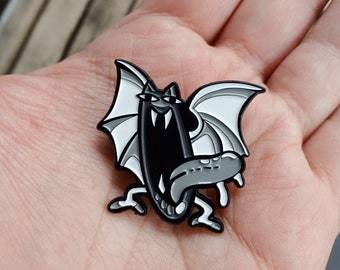
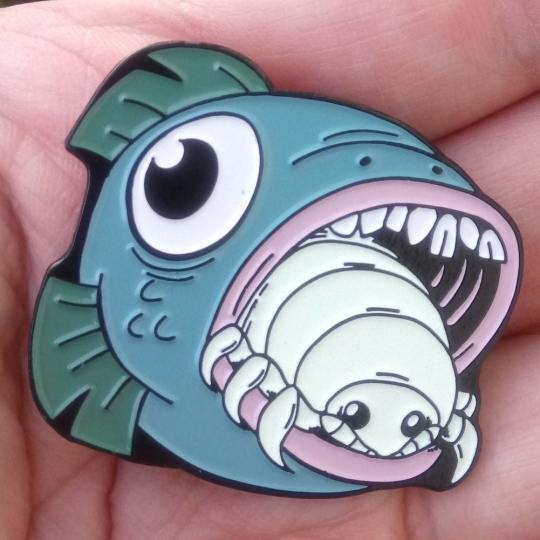
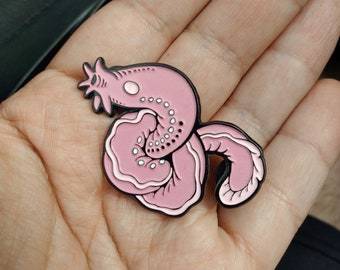


ETSY - I design all sorts of original enamel pins like these, plus I sell zero-maintenance terrarium plants (just leave them in a jar!), original books and other things!
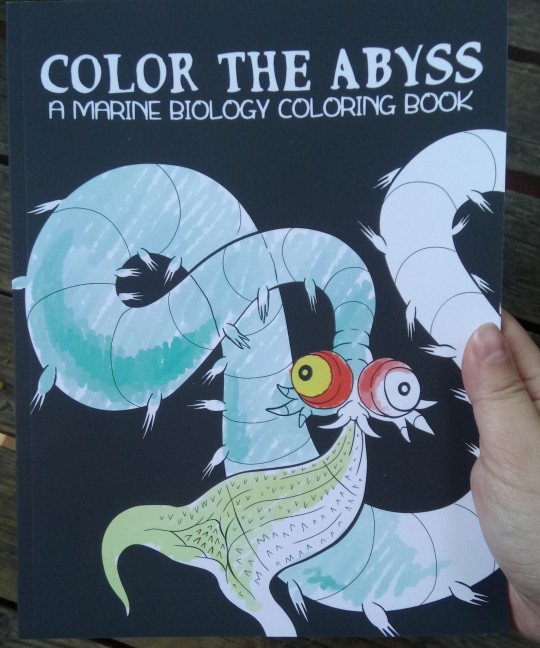

COLOR THE ABYSS (available on the above etsy!) - a 30 page educational deep sea coloring book! Includes a few famous favorites like giant isopods and hagfish, but mostly focuses on less popular, often much weirder animals.

UNBELIEVABLE BUGS - also regularly restocked in the etsy store, 30 of the strangest and most surprising arthropods most people have likely never heard of, illustrated by myself and @revretch, written for even the youngest kids to understand (but will likely teach you something new at any age)

My Itch.io and Ko-fi - both sell digital versions of my books, including some creepypasta collections and my first novel, "Return of the Living," about a world of entirely ghosts suddenly dealing with the appearance of ghost-hunting monsters.
TWITCH CHANNEL - I now try to stream something at least monthly, sometimes weekly when possible, from horror games to books and art.
YOUTUBE CHANNEL - archives my twitch streams and other little things.
INSTAGRAM - look at pictures of my huge weird collection of toys and Halloween collectibles
BLUESKY - I'm going to put mainly just updates to my stuff on here.
SEE ALSO:
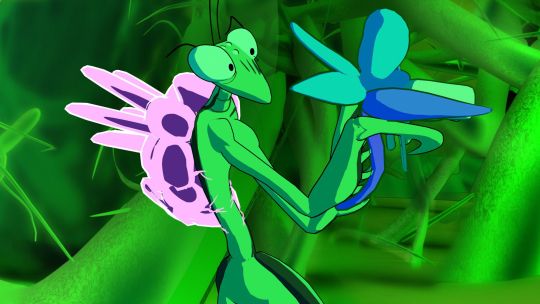
HUMANS-B-GONE - a science fiction animated series by my partner @revretch, about a world of kaiju-size, technologically advanced insects and arachnids to whom vertebrates like us are just pesky little "gubs." Also has a tumblr account @humansbgone
465 notes
·
View notes
Text
Wet Beast Wednesday: tardigrades
Last week on Wet Beast Wednesday I covered the largest animals to ever exist on our planet. This week I'm going to pull a full 180 and cover the smallest animals yet on this series. Meet the tardigrade, the internet's favorite micro-animal the is said to be basically immortal. How true is that? Let's see.

(Image: an electron microscope image of a tardigrade. It looks a lot like a potato with eight stubby legs tipped with long claws. At the front is a small, circular mouth. It has no other discernable features. In the background are bits of plant matter that look like seaweed at this scale. End ID)
The tardigrades are 1,300 known species (and probably a lot of unknown ones too) in the phylum Tardigrada. They are also part of the superphylum Ecdysozoa, which are animals that grow by molting their outer cuticles or exoskeletons. In particular, the tardigrades are believed to be a sister group of the arthropods, the group that contains crustaceans, insects, isopods, and a lot of other things. Tardigrades are truly tiny, the largest species reaching a whopping 1.5 millimeters in length, though most species reach no more than 0.5 mm. They have round, segmented bodies with four pairs of legs that end in either claws or suction discs. The body segments consist of a head, three body segments with a pair of legs each, and a caudal segment with the final pair of legs. The first three legs are used for movement while the final pair points backwards and is used for grabbing onto substrate. All of the body segments except for the final one correspond to segments found in the head section of insects. Tardigrades are missing many hox genes, genes that direct the body plan during development. Their ancestors may have had a body plan more similar to insects, but the loss of the hox genes has compressed them into walking heads with a bit of butt. The mouth is tubular and sucks in food. In the mouth are stylets, needle-like structures used to pierce food objects. Once food is drawn into the mouth, a structure called the buccopharyngeal apparatus activates. This is a combination of spines and muscle that acts like an inner jaw that pulls food into the digestive tract. The buccopharyngeal apparatus is distinct enough to be used as a major identifying feature between species. Tardigrades are translucent and many images you've seen of them have false color to show the details or are 3D models based on scanning electron microscope imagery of them. Tardigrades molt their exoskeletons multiple times (up to 12) during their lifecycle. Some species are unable to poop normally and instead all their waste is discarded during the molt. It was formerly believed that tardigrades could exchange genes with each other without mating, a process called horizontal gene transfer that is seen in bacteria, archaea, and other micro-organisms. It has since been discovered that while still capable of horizontal gene transfer, it is quite a bit rarer in tardigrades than we thought.
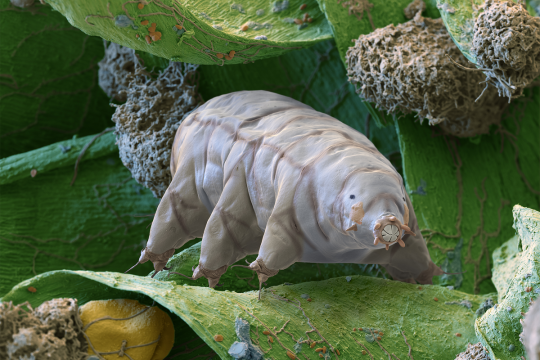
(Image: an electron microscope image of a tardigrade standing on a bit of plant matter. This one has a closed mouth with a ring of triangular tooth-like structures. It also has two simple eyes that look like black dots. End ID)
The name "tardigrade" means "slow walker", which is fitting as, despite their eight legs, tardigrades have a slow and awkward gait. This is the result of their legs being unjointed, only able to pivot at their connection to the body. Their gait has been compared to that of bears, hence why they are often called water bears and their discoverer, Johann August Ephraim Goeze, called them "kleiner wasserbär", meaning "little water bear". Tardigrades are found worldwide and have inhabited virtually every habitat, from the tops of mountains to the deep sea, from hot springs to the antarctic, from freshwater to saltwater. The one thing they have in common is a need to stay wet. Tardigrades can survive out of water as long as they can stay moist and are often found in mosses, hence another common name: moss piglets. The majority either eat plants or bacteria, but some will feed on smaller tardigrades or other micro-animals. Their famous survivability makes it easy for tardigrades or their eggs to be carried to new habitats by larger animals or other phenomena. Tardigrades are one of the first micro-animals to colonize a new habitat and they are a pioneer species, the first species to colonize a new environment and whose presence makes that environment fore suitable for other species to follow. Tardigrades are a major food source to other micro-animals and larger organisms. Most species have distinct males and females, though a few reproduce through parthenogenesis. In most cases, molting female will lay her eggs in her shed cuticle and males will them fertilize them. Other species have a form of internal reproduction. Males and females will court each other before mating and females will usually allow multiple males to fertilize her eggs. Female tardigrades are typically larger and more abundant than males. Eggs can take up to 14 days (species dependent) before hatching. All tardigrades of the same species have the exact same number of cells as each other. They are also born with the same number of cells they will have as an adult. Their growth is driven by enlargement of the existing cells rather than cellular reproduction making new cells. The lifespan ranges between a few months to a few years, depending on species.

(Image: a color photo of a tardigrade. It is a pale, translucent white, making it hard to make out details. Its body is curved, with the front end pointing at the camera. It has two simple eyes. End ID)
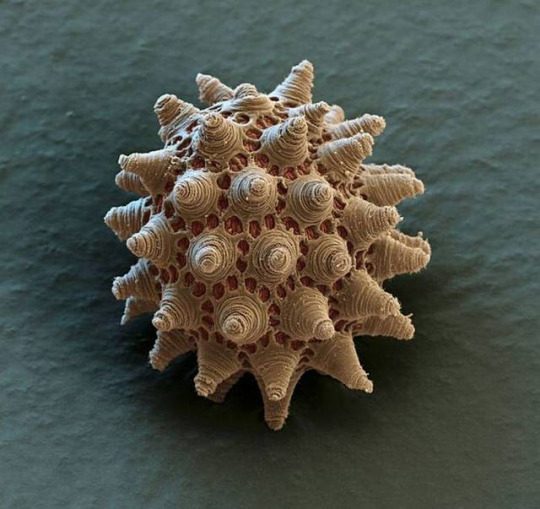
(Image: an electron microscope image of a tardigrade egg. It is round but covered in small pores and conical structures. End ID)
The most famous feature of tardigrades is their legendary durability. It is commonly said that tardigrades can survive just about anything (except for the things that are actually trying to kill them. They are prey to a lot of species after all). Among the things they can survive is extreme heat, extreme cold, dehydration, extremely high and low pressure, exposure to ionizing radiation (that's the scary kind), low oxygen environments, environmental toxins, heavy impacts, and the vacuum of fucking space. While the can survive in extreme conditions, tardigrades are not considered extremophiles. True extremophiles thrive in extreme environments and are negatively impacted by leaving them. Tardigrades can survive in extreme environments, but are negatively impacted and can't survive as well there as they can in less extreme places. The main trait that has allowed tardigrades to survive all five mass extinctions in history is cryptobiosis. Cryptobiosis is the rare ability for an animal to enter a state of dormancy where their metabolic processes come to an almost complete stop. While in cryptobiosis, metabolic activity drops to 0.01% normal and water content drops to 1% normal. In this state, the tardigrade is called a tun. Tardigrades usually enter cryptobiosis in response to arid conditions. One experiment showed that a species of tardigrade could last for at least 30 years in this state and return to normal lifestyle functions when exposed to water. Tardigrades will also enter cryptobiosis in response to low oxygen, toxic chemical exposure, increased or decreased temperature, and excessive salt content in the water. Tardigrades also show extreme resistance to both high and low pressure. They can live in 0 atmospheres of pressure and some species can survive up to 6,000 atmospheres, more than double the pressure at the bottom of the Marianas trench. More interesting is their ability to survive dangerous radiation. They can survive 1,000 times the dose of gamma radiation that humans can. Early tests focused on tardigrades in cryptobiosis and concluded that the extremely low water content of a cryptobiotic tardigrade doesn't leave much opportunity for the radiation to react with the animal. However it was later found that active and fully hydrated tardigrades are still considerably resistant to radiation. Studies into this resistance indicate that tardigrades can very efficiently repair damaged DNA and have unique proteins called Dsup that provides additional protection. Dsup introduced to human cells has provided additional protection against x-rays.
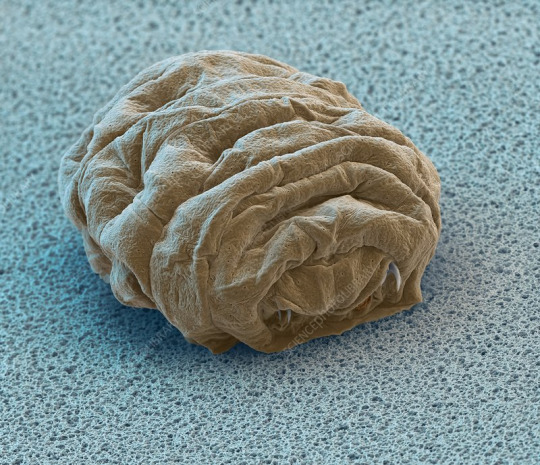
(Image: an electron microscope image of a tun - a tardigrade in cryptobiosis. It is smaller and very wrinkly, with the legs and mouth retracted into the body. End ID)
Tardigrades were the first animals to be exposed to the vacuum of space. They were exposed for 10 days, some in a state of cryptobiosis at the time of exposure and some still active. It was found that they were able to survive the vacuum when shielded from the sun's ultraviolet radiation, with those already in cryptobiosis doing better. Upon being rehydrated, many were able to resume normal life functions and successfully reproduce, though others died after being rehydrated. Those that were exposed to UV radiation fared much worse, with only a few hydrated individuals surviving. The individuals in cryptobiosis had a lower survival rate when exposed to UV than those not exposed to UV and were less successful at reproducing afterwards. Studies of tardigrade's space survival abilities and resistance to radiation could go a long way in helping human space travel. One of the largest dangers of space travel is that space is full of nasty radiation from the sun that Earth's magnetic field protects us from. Some scientists speculate about the possibility of accidentally seeding other planets or moons with tardigrades or other space-resistant organisms. This is a problem because introducing Earth life to other world has the potential to damage any native ecosystems and if we find life in space in the future we don't want to have to figure out if it's something we accidentally put there. While tardigrades could likely survive on other planets, they would eventually die without a food source. Some sources reported that tardigrades may have colonized the moon after an experiment with them crashed. Unfortunately, the moon is not crawling with tardigrades now. It's way too dry for them to exit cryptobiosis even if they survived the crash, which they probably didn't.
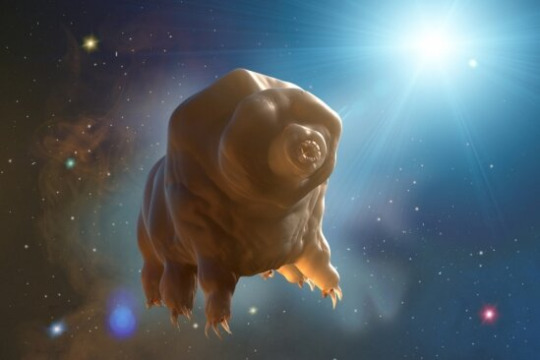
(Image: art of a tardigrade floating in the vacuum of space. End ID. Source: University of California - Santa Barbara)
#wet beast wednesday#tardigrade#water bear#moss piglet#micro animal#microbiology#marine biology#biology#zoology#ecology#animal facts#informative#science#space#astrobiology#radiation#cryptobiosis#tun#image described
164 notes
·
View notes
Text
shoutout to furries with “weird” or “nonstandard” fursonas
frilled lizards and aye ayes and sea birds. slugs and snails and octopi. specific species of deep sea fish. salamanders and newts. microbats with the funky noses. every arthropod ever. i will smooch u youre blessed and valid
2K notes
·
View notes
Text
Spectember D20: Scavenging/Detritivory
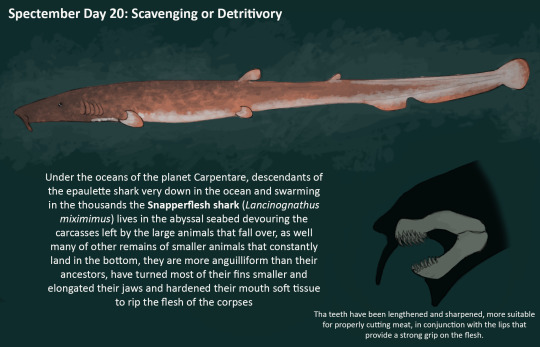
Far away in another world, a tropical planet of minor size than earth called Carpentare, humanity landed there and as many other worlds picked a selected variety of animals to fill its landscape, for the lots of shallow tropical seas they picked lots of reef and tropical animals with only the vertebrate to wander in the coasts are epaulette sharks. And once when man left, they dominated first every region of the ocean and then some ventured to land, although for this entry we are going to look for the deep bottom and an important part of the trophic chain that was covered 40 million years after, the scavengers.
Deep bottom on the 2000 m depths of the abyssal areas many of the large whale shark sized species when they die if they aren’t fully devoured by macropredator forms they start falling directly for the bottom, which many crustaceans, echinoderms and mollusk devours the remains, although there has been a group that has benefited of this behavior as well, they resemble something more primitive from earth but they are still sharks. The snapper flesh shark (Lancinognathus miximimus) is a deep-water species coming from an eel-shaped group o seabed dwelling sharks, many specialized in eating small prey, through the snapper flesh started to get more substantial food from those animals that fell off the surface, as they act like hagfishes searching for the remains of large animals, they gather in great numbers and consume these fully, faster than the arthropods and echinoderms around them.
56 notes
·
View notes
Text
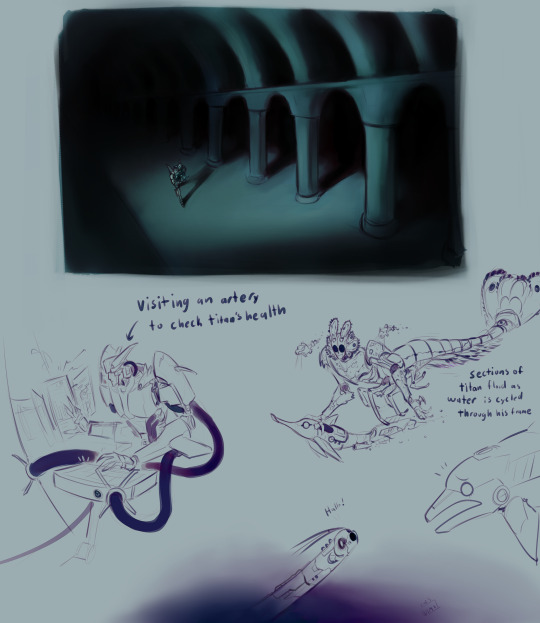
There is a separate, seldom seen group within the city of Oardivia: the Titan Maintenance Team, or TMT. In comparison to the rest of the population, the TMT are few in number, barely reaching a hundred or so individuals. The titan maintenance drones they work alongside outnumber them 1,000 to 1.
TMT mechs and drones dwell within the buried city titan their entire lives, forged specifically to thrive in the dark, lonely corridors of the titan with deep sea alt modes (often deep sea sharks and fish with a few arthropods and even octopuses and squids) and delicate sensors. They are an antisocial and quiet bunch, perfectly content with not seeing one another for potentially years at a time. For the most part, their only company are the little drones that follow them around.
Despite being virtually harmless and shy people, their adaptations do tend to make them look cryptic, with long, sometimes multiple limbs, slouched postures, starved appearances, dull colorations and blank stares. Some are even without eyes (*cough*Slumber*cough*), and many walk and swim at a slow, almost zombie-esk pace. They can move quickly if they need to, of course.
Startling appearances and agonizingly slow movements aside, the TMT are very busy mechs. They constantly patrol Tectonichus’ halls, searching for any damages that need repairing and overall keeping a close eye on the health and activity of the metrotitan. They also report any intruders if they can’t chase them out themselves.
The only times a TMT crew member leaves the titan are either for medical attention, or to report any unusual/worrying activities within the titan. Because of this, it’s said that spotting a TMT mech out in the open is a bad omen.
#my art#transformers#transformers oc#slumber#frillbyte#the shrimp guy is quickfin who is rungs husband’s oc on Tik Tok#world building#oardivia#titan maintenance team
152 notes
·
View notes
Text
We've noticed a gap in language for specifically referring to animals in systems that function like/mostly like normal animals. so I'm coining this term. I have been using it for awhile now in therapy and when talking to other we know systems.
Beastie (plural Beasties)
Refers to animal alters/headmates in systems/collectives that cognitively function in a way different than that of the non-animal altars/headmates in the system/collective.
Beasties do NOT need to be known animal. They can be anything that would be clearly identified as an animal (e.g mythical beasts, fictional hybrids, speculative animals, elemental animals, and the like)
Not all animals in systems/collectives are beasties due to the fact that the term refers to a animalistic way of functioning. Whether or not the term applies to a certain alter/headmate is intentionally somewhat vague, and and is dependent upon the context of the other alters/headmates in the system/collective.
Differs from the term non-human alter/headmate in that not all non-human alters/heamates are animals, and a lot of non-human alters/headmates function cognitively similarly to their human counterparts.
I am part of a OSDD-1"B" system, and consider myself "Endo complex", I don't care what type of system/plurals use this term. As I'm coining it to fill a gap in language.
HOWEVER I would like this term to be exclusive to systems/plurals, and exclusively to refer to alters/headmates that are literally animals. So it is not to be used in contexts of pet regression, animal-hearted, otherkin/therianthropes, petplay, etc. That is just not what the term is meant to be used for.
And here's a flag just for fun


with and without symbol. symbol used here. If anyone is willing to design a unique symbol specifically for this flag I would greatly appreciate it.
Navy Blue is for aquatic beasties such as fish, sharks, aquatic mammal, aquatic invertebrate, etc.
Deep Sea Green is for amphibious and semiaquatic beasties such as frogs, salamanders, newts, caecilian, river otters, crocodilians, penguins, etc.
Forest Green is for terrestrial and arboreal beasties such as most mammals, birds, reptiles, and many arthropods.
Olive Green is for herbivorous beasties such as horses, toucans, sloths, deer, tortoises, hummingbirds, aphids, bees, and many more.
Beige is for omnivorous beasties such crows, hogs, bears, canines, some lizards, chickens, many Testudines, and many more.
Brass is for carnivorous and insectivorous beasties such as felids, birds of prey, snakes, crocodilians, spiders, sharks, most bats, some lizards, and many more.
Brick Red is for beasties that are animals that can exist in the outerworld, like the animals mentioned above. This stripe is also for beasties that are Introjects or factives of real animals.
Purple Red is for hybrid beasties which could be something possible in the outerworld like ligers, or something impossible like griffins. This stripe is also for beasties that are Introjects or faitives/fucktives of animals.
Deep Violet is for beasties that are mythical creatures such as dragons, unicorns, phoenixes, cryptids, and more. This stripe is also for beasties that are Introjects or fictives of fictional animals.
#-v#Beastie#Beasties#system terms#coining#plural term#system coining#plural coining#flags#my flags#non human alter#animal alter#endo neutral#plural system#osdd system#traumagenic system#did alter#did system#dissociative system#osdd alter#our flags
18 notes
·
View notes
Note
What's your favorite animal, don't fuck around and say like, "dog" either.
Man, i love animals. There's just no picking a single favorite, so here's a few that comes to mind.
Corvids like crows, ravens, magpies. They're intelligent and curious and can be drawn with so much expression. Rats and mice share the same characteristics and are really cute to boot.
I love insects and other arthropods. They're not always relatable but they fascinate me. Little biomechanical robots that come in all shapes and colours and behaviours.
Deep-sea biology is also an endless source of inspiration. All those alien beings evolved to live down there.
Crocodiles and sharks kick ass, they're ancient designs from a time long before ours.
Monkeys and apes and how similar they are to us.
Whales are cool too. Living blimps just chilling out in the ocean.
Those are a few that i always enjoy drawing, but i could ramble on and on.
Fun question!
25 notes
·
View notes
Note
Hai! Arthropod fact/🪳 anon here again >:3
Did you know pill bugs are not insects, but actually are crustaceans? The main thing that gives this away is that they have more than 6 legs, and insects only have the 6. But pill bugs have 14! This is also evident given the presence of the deep sea isopod! :3
So next time an isopod shows up to the bug association meeting, you may want to break the news to everyone :(
Finally I can get rid of those annoyances in the bug council.
#regretevator#ask blog#pest#regretevator pest#pest regretevator#answered#anon ask#bug facts!!!#I love you bug anon
12 notes
·
View notes
Text
These are some of my favorite, less well known, non-malacostracan crustaceans!
Mystacocarids
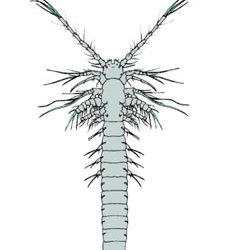
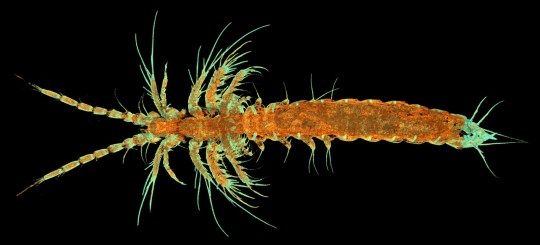
They are usually placed in a group with Ostracods, that is basal to all other extant crustaceans, meaning crabs, barnacles, and bees are all more closely related to each other than they are too Mystacocarids. They live in between grains of sand on beaches in many parts of the world. They get up to 1 millimeter long. I like how they kinda look like feather dusters, or like stretched out lice with too many legs.
Cephalocarids or Horseshoe shrimp
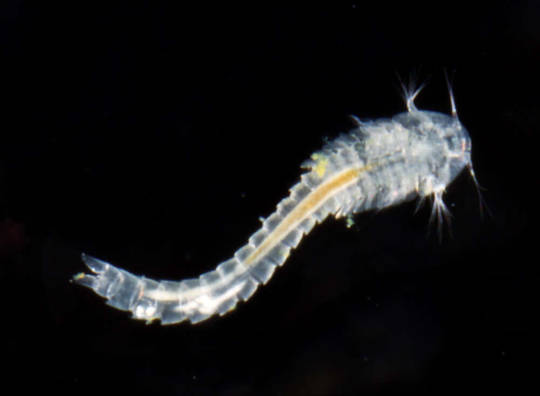
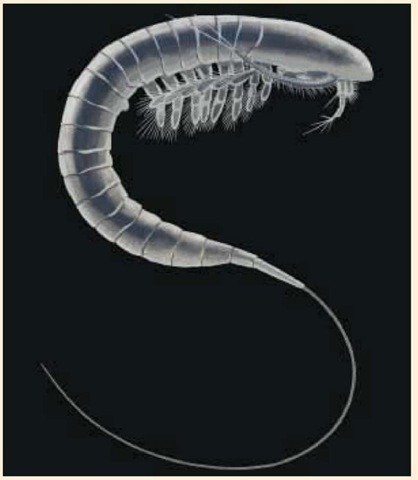
These guys were only discovered in the 1950s century and since then have been grouped with the remipedes, although recently they typically are instead placed in their own group! They are benthic organisms that live in all kinds of sediment from the shore to the deep sea, and typically eat detritus. They are hermaphroditic, have no eyes , and get up to 4 mm long! I think they look a lot like some primitive, Cambrian era arthropods, and despite being small and probably not likely to fossilize, their fossil record extends back to Ordovician, so the appellation of them being "Cambrian survivors" may very well be accurate.
Notostracans or Tadpole Shrimp


Consisting of the genera Triops and Lepidurus, this group of animals is most closely related to water fleas and clam shrimp , and more distantly to fairy shrimp (such as the famous sea monkey brine shrimp). Like brine shrimp, Triops are a common pet. Both genera are known to have populations in temporary pools of water, and have long lasting eggs that can survive desiccation and years without water before hatching again when the water returns. They also can live in shallow lakes, certain wetlands, and other more permanent ponds, and depending on species live in fresh, brackish or even salt lakes, but don't live in marine environments. They are omnivores and will basically eat anything, including smaller members of their own species. For a relatively small group of crustaceans, they have a wide variety of reproductive strategies, with some populations having sexually reproducing males and females, some having exclusively self fertilizing females, others being primarily hermaphroditic, and still others being different mixes of these. This variation is present even in different populations of the same species. They can get up to about 7 cm long , making them much larger than the previously mentioned crustaceans, but not big enough! They are so cute I wish they were big enough I could give them hugs. I think they should be the size of cats .
Remipedes


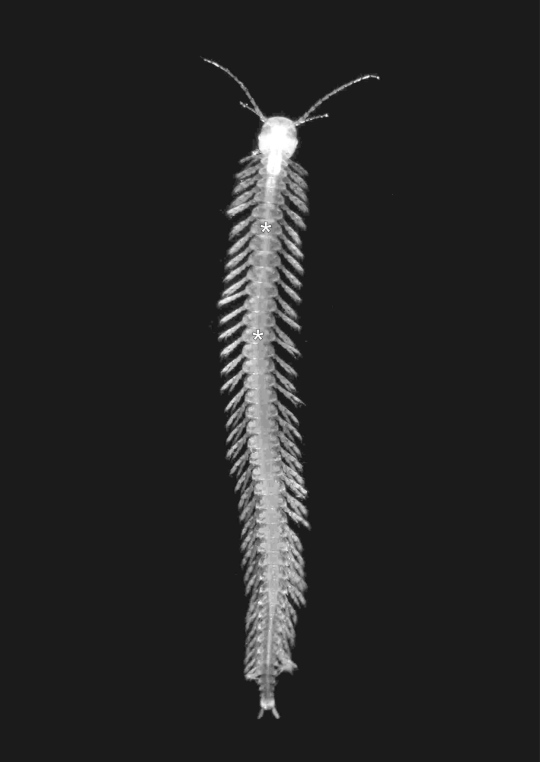
Remipedes are really special, the first living remipedes were only discovered in the late 1970s, and weren't properly described until 1981, meaning our knowledge of living remipedes is only as old as goth music. To be honest their lifestyle is pretty goth too, they exclusively live in caves and aquifers, typically in subtropical , coastal regions. As befitting creatures of the dark, they have no eyes or pigmentation, and instead have an advanced sense of smell. While they are also capable of filter feeding, they have venomous fangs that they use to predate on smaller organisms, and indeed are the only venomous crustaceans (outside of insects). Unlike the predatory adults, remipede larva don't seem to eat at all, and it's speculated that they may instead derive nutrition from symbiotic bacteria. Remipedes have 32 segments, and being hermaphroditic, have female and male openings on different segments of their bodies (7 and 14, respectively) . Despite their seemingly primitive bodies and strange lifestyle, remipedes have actually been discovered to be the group of crustaceans that are closest to the Hexapods, including the insects! They get up 4 cm long but I wish they were as long as eels.
I also kinda wanted to write about clam shrimp here but their phylogeny is a bit of a mess right now and I'm not even sure what qualifies as a clam shrimp anymore. They basically look like little clam shells with a crustacean swimming around in them.
15 notes
·
View notes
Text

Common Sea Monkey/Mermaid
Kingdom: Animalia
Phylum: Chordata
Class: Mammalia
Order: Primates
Suborder: Haplorhini
Infraorder: Simiiformes
Clade: Hydropithecoidea
Family: Hydropithecidae
Genus: Hydropithecus
Speices: H. ichthyophilus (“fish-loving water ape")
Ancestral species: possibly Eosimias sinensis
Temporal range: Pliocene to recent (3.0 mya - present)
Information:
Though seal-like in appearance, H. ichthyophilus, better known by the natives as *sunsaapali* and to the English-speaking world as the mermaid or common sea monkey, is, as its name suggests, not a pinniped, but rather, an aquatic primate. A member of a broader clade known as the hypdropithecoids or sea monkeys, the ancestors of this clade were likely basal simians (though its exact placement in the primate family tree cannot be determined by morphology alone since it shows a mosaic of features found in both the New World and Old World clades of monkeys, as well as features which point to a stem-simian origin) which made the transition from land to sea sometime in the late Miocene (though the common sea monkey itself is a relatively young species, with the oldest fossil material dated to around 3 million years ago in the late Pliocene). Around 10 feet in length and around 800 lbs in weight, this creature is among the larger members of its clade. Sexual dimorphism is minimal, with males being only slightly larger than females and sporting larger canines. It is also the most widely-distributed member of its clade, being found in open ocean habitats all across Archaeonesia with a total wild population of around 90,000 mature individuals, whereas most of its relatives are confined to the deep coastal waters east of the Isle of Perils. Primarily a pelagic predator, this creature’s diet is incredibly varied, going after small marine reptiles (including venomous sea snakes), a wide assortment of open ocean fish, cephalopods (including ammonites), flying sea birds, pterosaurs, and even flightless birds like penguins and some varieties of auks. This species is known to dive to the twilight zone, as far as 2,000 feet deep, in the search for food, where it hunts large deep-sea arthropods. Most of the water it needs to survive is obtained through its food. Coloration in this species is highly varied. The most common color variant is the “skipjack” one, named after its similarity to the color patterns of the skipjack tuna with its blue and white countershading. However, other color morphs exist, including a melanistic, leucistic, dark brown, light/sandy brown, “humpback” (gray and white like the whale it’s named after), mottled grey and white, and a piebald one.
A highly social and intelligent aquatic primate, the common sea monkey has a highly complex matriarchal social structure, living in family groups of up to 30 individuals. Pack-hunting is a common phenomenon and typically occurs when hunting larger prey, the younger and more limber juveniles corralling prey towards the larger and more powerful adults. Orphaned young are often cared for by other female members of the group, and young are frequently passed around from adult to adult when the respective parents of the young sea monkeys are off foraging. Though a formidable predator in its own right, it is still subject to predation from other ocean-going predators, namely whales, sharks, and large marine reptiles. To counter this, the common sea monkey uses a variety of “songs” to indicate both the identity of the predator as well as how close it is to the group. A highly vocal animal, this species communicates with a wide variety of sounds other than just “singing”. Clicking is a common vocalization, seemingly a form of echolocation as is seen in dolphins. Barking and gurgling are both used to convey aggression. This creature’s eyesight is superb, allowing it to see in pitch black seas. Like dolphins, it sleeps with one eye open and can hold its breath for hours at a time. A swift swimmer, it relies on its speed and maneuverability to escape predators, though it will attack if seemingly cornered, biting its attacker viciously. Another common way to evade predators is to spontaneously void its bowels, clouding the way with a noxious cloud of feces which both disorients its attacker and overwhelms its sense of smell. Breaching is a frequent behavior and appears to be done to swiftly grab seabirds or pterosaurs out of the air. Curious animals, they will readily approach divers and may also jump onto boats to escape predators. Some may even offer divers fish or crustaceans seemingly as a peace offering, a common gesture between sea monkey family groups.
This species mates year-round, although it occurs most frequently during November and December. The large tusks of the male are a secondary sex characteristic and are typically merely for show rather than function. The larger the tusks, the more attractive he is to females. Unusually for mammals, this species exhibits polyandry, with females having multiple mates. Gestation takes around 6 months, and the babies are born without claws or teeth to avoid injuring the mother during birth, being born feet first as well to prevent the risk of drowning during birth. Full size is reached by 2.5-3 years old and sexual maturity by 4. Young males are kicked out of the group by this period, which leads them to seek out other family groups to join, while the females typically stay with their original family group. In the wild, they can live as long as 26-30 years and in captivity, they can easily live to 34-40 years.
Though it primarily dwells in open oceans, these creatures are known to occasionally enter coastal waters and come ashore, particularly during tropical storms, which has led to a belief in many regions that these animals bring storms. Despite this association, these animals are seen rather positively by the natives. In other regions, these creatures are believed to be the reincarnated souls of sailors who died at sea. On the eastern coast, their tendency to swim alongside the outrigger canoes of the Banguani people, a culturally Polynesian minority in the region, up and down the coastline in search of food has led to a more humorous name amongst some as “Banguani sea dogs”, the idea based on the belief that the Banguani had a special association with these animals. Indeed, there is some truth to this. The Banguani people consider the common sea monkey to be the spirits of their ancestors and sometimes pay tribute to the animals by offering them some of their catches. In some areas, this species was also a historic food source, being heavily hunted in antiquity, with cave paintings all throughout the region directly depicting this. In the modern day, few people eat these animals, namely due to the fact that since they’re now known to be distantly related to humans, there is a fear of pathogens spreading from common sea monkeys to our own species, but many still hunt them for their teeth and tusks or to take their young, which are highly sought-after by aquariums and wildlife institutions abroad for their unique biology. Nicknamed the “mermaid” for its passing resemblance to the mythical creature, fringe theories suggest that a population of these creatures which escaped Archaeonesia when the border mountains crumbled back into the sea might be responsible for myths of mermaids and selkies. Interestingly, along the southern seas of the Isle of Perils, this creature is very rare, possibly due to the presence of seals and sea lions, which suggests that there may be an element of competitive exclusion between the two groups. It is sympatric with most other species in its clade, though there appears to be little interspecies competition between them, suggesting some level of niche partitioning. Remains of common sea monkeys have occasionally been found in the stomachs of giant deep-sea cephalopods, suggesting that some deep-sea creatures may prey on them. When dying, these animals are known to isolate themselves, seemingly swimming to shallow waters or nearby shorelines to die, a behavior suggested to have an evolutionary basis: by isolating themselves, the smell of their dead body will not attract predators to the larger group and therefore risk additional casualties.
#original species#novella#speculative evolution#fantasy#scifi#scififantasy#speculative biology#speculative fiction#speculative zoology#worldbuilding#creature art#sci fi#fantasy worldbuilding#fantasy creature#scifi worldbuilding#scifi creature#aquatic ape theory#sea monkey#mermaid
5 notes
·
View notes